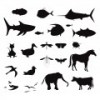Just in case you were ever wondering what a beetle looks like on the inside, here is a computed microtomography video of a Dryops water beetle.
Other researchers are using this tool to examine the anatomy of various extant and extinct organisms. In fact, there is an online digital library of specimens that you can explore at The University of Texas at Austin (sponsored by the National Science Foundation).
Here are a few of my favorites:
Panaque cf. nigrolineatus, Royal Pleco Catfish
Dr. Nathan Lujan - Texas A&M University

Juvenile Gila Monster (Heloderma suspectum) (false-color 3D reconstruction)
Sample courtesy of Dr. Kevin Bonine, University of Arizona, Tucson

Chamaeleo calyptratus, Veiled Chameleon
Dr. Jessie Maisano - The University of Texas at Austin

Strongylocentrotus purpuratus, Purple Sea Urchin
Ms. Ashley Gosselin-Ildari - Stony Brook University

Each image is accompanied by a host of information on the species, the particular specimen used in the imaging, as well as the scan. What an amazing resource!
